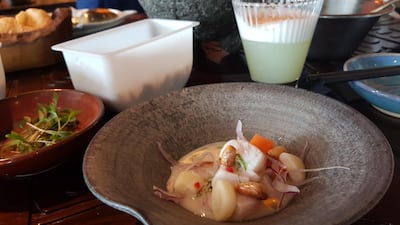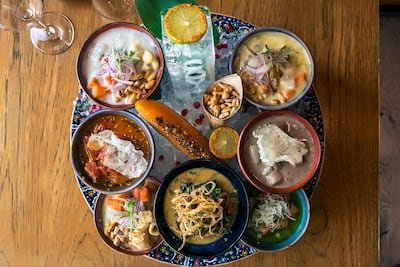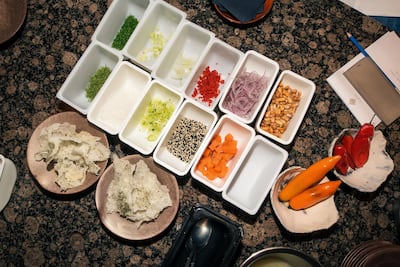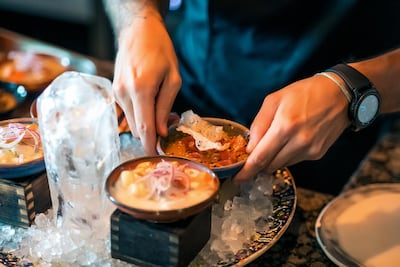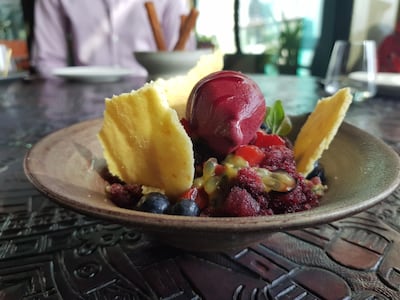It says much about where we are that in Coya Abu Dhabi, one of the restaurants that kick-started the craze for Peruvian food, our barman is Romanian, the chef is Italian, but found his way into the cuisine via Japan, and the kitchen staff are from the Philippines, Indonesia, Malaysia, India and Ukraine. It is equally unsurprising, then, that some of that international flavour has imprinted itself on the menu and one of the leches de tigres – literally, tiger's milk, the sauce in which raw fish marinates to make Peru's classic national dish, ceviche – has a truffle base that wouldn't be amiss on pasta.
“I called my grandma and said: ‘You’ll never guess what they’re doing now – they’re putting truffle and soy sauce in their ceviche,’” says restaurant supervisor Tito Bay, one of the few Peruvian members of staff. “She replied: ‘Come straight back to Peru.’”
But if the Coya staff have a multinational flavour, so does the cuisine, whatever Bay’s abuelita might say. There is a significant Japanese and Chinese influence on Peruvian dishes, thanks to 19th and early 20th-century settlers – so much so that the fused Chinese cooking style has its own name: chifa. Most cities in Peru have a chifa neighbourhood as a result, and two of Coya’s six leches de tigres are called chifa and nikkei accordingly, with spiky soy and chilli paste, and wasabi and ginger bases, respectively.
The cuisine has been enjoying a moment in the Middle East recently. Coya Dubai was the first to open its doors in the UAE in 2014, followed by a spate of other restaurants, including Mayta, Aji and Waka. In the capital, Limo opened in December 2016, followed by Coya Abu Dhabi a few months later, but it took some time for wary diners to be persuaded to try some of the more unfamiliar dishes. In the beginning, says Bay, Coya had to give away bowls of ceviche for free to persuade suspicious diners from the region to try it.
Now the restaurant ploughs through 120 kilograms of fish every week.We are learning just what goes into a ceviche at a masterclass in the Abu Dhabi outpost. Deceptively simple-looking, ceviche, for those unfamiliar with this tantalising dish, is made of small chunks of raw fish, anything from snapper and sea bass to salmon and tuna, cured in the acidic juices of citrus fruit, then adorned with vegetables and herbs to give contrasting textures, flavours and colour, from diced sweet potato, avocado and slivers of red onion to a sprinkle of coriander and choclo, or giant corn. The combinations are endless. A drizzle of leche de tigre is the final touch – just enough to marinate it, but "not enough for the fish to swim back to the sea", says our masterclass instructor, Turin-born junior sous chef Nicola Negrini.
For a lazy cook like me – my default position is anything that involves more than three ingredients is too much effort – ceviche had huge appeal: no real cooking involved and ingredients you could find languishing at the back of your fridge. That is, until I learn about the level of precision and artistry that goes into assembling this seemingly straightforward concoction. Rather like the first flush of grapes or olives, limes are precious to Coya, which uses only the first, sweetest squeeze for the base of its sauces. The second is deemed to be too bitter and acidic, and can ruin the flavour of the ceviche. Chillies are roasted to enhance the flavour before being pureed. And this is just the marinade. Lime and chilli form the basis of any leche de tigre and give ceviche its distinctive, subtly spicy tang; without those two staples, it simply isn't authentic, declares Negrini. To that, Coya adds celery, onion and fish stock, as well as the flavours that turn a clasica into something especial.
Drinks in hand, we get to work tossing cubed sea bass in lime juice. Within minutes, it turns white as it cooks in the acidic liquid. We pile our fish into little bowls, looking rather less like the elegant pyramids demanded by Negrini and more like the deconstructed design of the Guggenheim Abu Dhabi. On the fish, we scatter a few sprigs of coriander, some red onion, sweet potato and choclo, then delicately spoon in some sauce – thankfully, it has been prepared in advance – and voila, it seems we have created our own ceviche clasica. It’s delicious, too, although I suspect if we had to make our own completely from scratch, the results might be starkly different.
Peruvians tend to eat ceviche in the morning and early afternoon, when the fish is at its freshest, arriving on boats in the morning haul. Leche de tigre can sometimes be served alongside it in a shot glass, a sharp and pungent kickback to start the day.
As with all classic national dishes, ceviche and its origins are fiercely contested. Peru has long been engaged in a battle with Chile for authenticity – legend has it that it was first brought to Peruvian shores by the Moors from Spain, a story that brings Peru’s layered and complex multinational flavours full circle. As someone who has devoured bowl after bowl in travels around Latin America, for me it’s a close call, but Peruvian ceviche certainly has the edge.
I won’t lie, though; it’s unlikely I’ll be making my own any time soon. The masterclass finishes with our group of seven – four young commercial lawyers on a six-month secondment to Abu Dhabi and a British couple, who are long-standing residents – being treated to a fabulous spread of tapas-style dishes: tiger prawns basted in aji chilli paste on skewers, a citrusy twist on the maki roll, baby chicken smothered in the ubiquitous aji panca (red pepper) and a delightful Chilean sea bass risotto with a twist of lime. We finish with zesty churros dipped in a milk chocolate sauce, and frozen Peruvian corn blended granita-style with passion fruit and strawberry and topped with orange shortbread.
It’s a mind-blowing feast, completed by a view over the sparkling waters of the Gulf and sprinkled with a little fairy dust that would be impossible to replicate at home – the passion and devotion of chefs and waiting staff from all around the world, bringing a little touch of Peru to Abu Dhabi.
The next ceviche masterclass will be held at Coya Abu Dhabi on July 27. Contact 02 306 7000 or reservations.ad@coyarestaurant.ae
